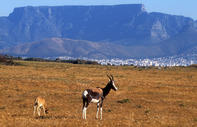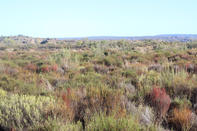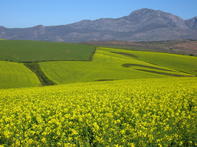Bush of the Rhino
Renosterveld acquired its name from the innocuous little shrub 'renosterbos' (literally 'rhinoceros bush', or Elytropappus rhinocerotis), which was probably so named because of the black rhino that once grazed where it occurred. The earliest settlers in the Cape - the pastoralist Khoi-khoi and later Europeans - would have seen large game on the foothills of the Cape Fold Mountains.

Herds of bontebok, eland, zebra-like quagga and bluebuck once grazed these slopes along with rhino. Sightings of such large herbivores should have been the first clue to the ill-fated future of renosterveld because the big game fed where the nutrients were high. And, where nutrients were high, cattle herders could graze their domestic stock and settlers could grow their grain, fruit and canola crops.
No Man’s Land

The nutritional superiority of renosterveld areas over fynbos, where no grazers much larger than the size of an average domestic dog were found, results from the more mineral-rich nature of the parent rock that makes up the granite and shale soils which, over the millennia, have been exposed by geological processes.
This richness, along with the nutrient-trapping clay nature of the soils and lower rainfall, combined to form the perfect habitat for what is not quite fynbos and not at all succulent karoo. 'Where rainfall is greater than about 600 millimetres, renosterveld is replaced by fynbos, and where it is less than 250 to 300 millimetres succulent karoo takes over'.
Renosterveld is a kind of no man's land between the two that looks like nothing but is loaded with life. Dr Anton Pauw, a specialist in the ecology and evolution of plant-animal interactions, points out that the true glory of renosterveld lies hidden beneath the shrubs. Here, concealed from view for most of their lives, is a latent kaleidoscope of flowering bulbs.
To botanists, this represents what Lagavulin does to single malt drinkers. Or, as Pauw describes, it's the connoisseur's garden. Lillies, irises, orchids and amaryllis bulbs by the hundreds are buried in the dirt, just waiting for a fire to rip through the renosterbos to give them a small window of light and nutrients to burst forth into flower.
Flitting between them, in a flurry of activity, are the myriad little pollinating bees, flies, beetles and wasps whose job it is to ensure that the bulbs always have offspring.
The Environmental Decay of the Veld

Renosterveld was once common on the west and south coast lowlands of the Cape until Homo sapiens arrived with their guns, plough shears, wheat, fruit and hungry cattle. First, the megafauna disappeared under a volley of bullets. Extinction came fast for the bluebuck, quagga and the Cape lion that fed on them. Then, as farmers spread across the valley floor, they created an ocean of rippling grain which now laps at the feet of the Western Cape's mountains.
Peeking out of this beige sea are a few islands of renosterveld and whatever fauna has managed to scramble to safety. The jetsam of an evolutionary marvel, discarded and slowly dying.
After 300 years, an estimated three to four per cent of West Coast renosterveld remains - most of it in little patches atop distant hills and in shadowy dales, saved from the tractor by virtue of steep slopes, rocky outcrops or marshes. Conservationists are hurrying to protect these renosterveld remnants but, in line with the principle of small islands being most vulnerable, they are most at risk of environmental decay.
By Leonie Joubert